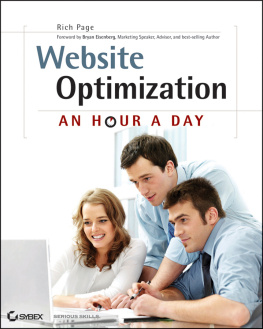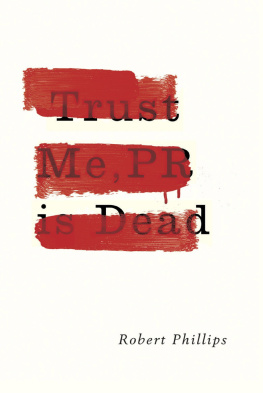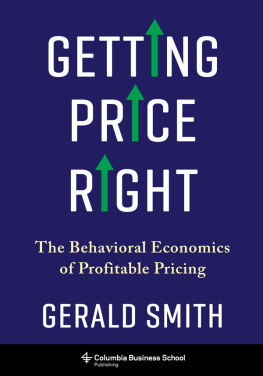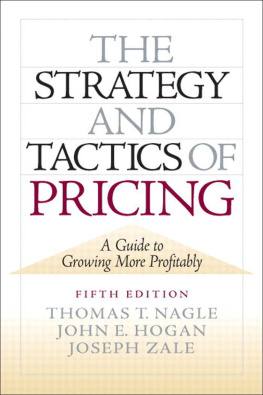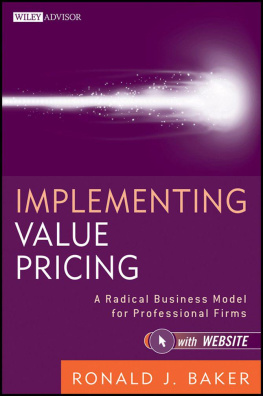Robert L. Phillips - Pricing and Revenue Optimization
Here you can read online Robert L. Phillips - Pricing and Revenue Optimization full text of the book (entire story) in english for free. Download pdf and epub, get meaning, cover and reviews about this ebook. year: 2021, publisher: Stanford University Press, genre: Business. Description of the work, (preface) as well as reviews are available. Best literature library LitArk.com created for fans of good reading and offers a wide selection of genres:
Romance novel
Science fiction
Adventure
Detective
Science
History
Home and family
Prose
Art
Politics
Computer
Non-fiction
Religion
Business
Children
Humor
Choose a favorite category and find really read worthwhile books. Enjoy immersion in the world of imagination, feel the emotions of the characters or learn something new for yourself, make an fascinating discovery.

- Book:Pricing and Revenue Optimization
- Author:
- Publisher:Stanford University Press
- Genre:
- Year:2021
- Rating:4 / 5
- Favourites:Add to favourites
- Your mark:
- 80
- 1
- 2
- 3
- 4
- 5
Pricing and Revenue Optimization: summary, description and annotation
We offer to read an annotation, description, summary or preface (depends on what the author of the book "Pricing and Revenue Optimization" wrote himself). If you haven't found the necessary information about the book — write in the comments, we will try to find it.
Pricing and Revenue Optimization — read online for free the complete book (whole text) full work
Below is the text of the book, divided by pages. System saving the place of the last page read, allows you to conveniently read the book "Pricing and Revenue Optimization" online for free, without having to search again every time where you left off. Put a bookmark, and you can go to the page where you finished reading at any time.
Font size:
Interval:
Bookmark:
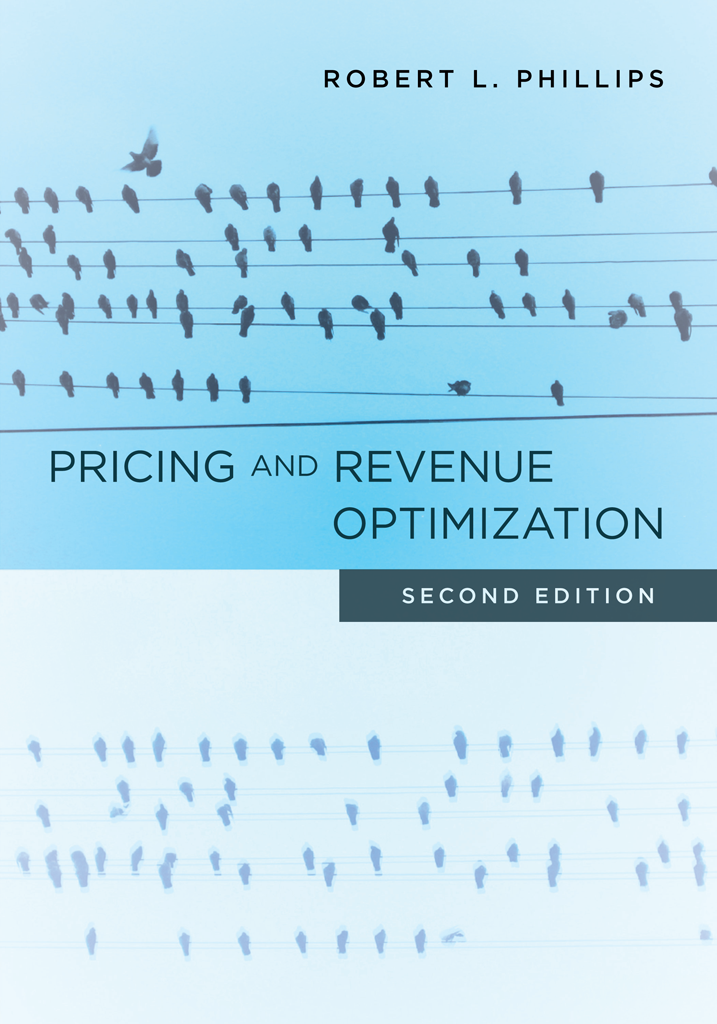
PRICING AND REVENUE OPTIMIZATION
Second Edition
ROBERT L. PHILLIPS
STANFORD BUSINESS BOOKS
An Imprint of Stanford University Press
Stanford, California
Stanford University Press
Stanford, California
2021 by the Board of Trustees of the Leland Stanford Junior University. All rights reserved.
No part of this book may be reproduced or transmitted in any form or by any means, electronic or mechanical, including photocopying and recording, or in any information storage or retrieval system without the prior written permission of Stanford University Press.
Special discounts for bulk quantities of Stanford Business Books are available to corporations, professional associations, and other organizations. For details and discount information, contact the special sales department of Stanford University Press. Tel: (650) 725-0820, Fax: (650) 725-3457
Printed in the United States of America on acid-free, archival-quality paper
Library of Congress Cataloging-in-Publication Data
Names: Phillips, Robert L., author.
Title: Pricing and revenue optimization / Robert L. Phillips.
Description: Second edition. | Stanford, California : Stanford Business Books, an imprint of Stanford University Press, 2021. | Includes bibliographical references and index.
Identifiers: LCCN 2020021124 (print) | LCCN 2020021125 (ebook) | ISBN 9781503610002 (cloth) | ISBN 9781503614260 (ebook)
Subjects: LCSH: Pricing. | Revenue management.
Classification: LCC HF5416.5 .P457 2021 (print) | LCC HF5416.5 (ebook) | DDC 658.15/54dc23
LC record available at https://lccn.loc.gov/2020021124
LC ebook record available at https://lccn.loc.gov/2020021125
Cover design and photography: (based on first edition design by) Lee Friedman
Typeset by Newgen in 10/13.5 Minion
CONTENTS
PREFACE TO THE SECOND EDITION
This book originally grew out of courses in pricing and revenue optimization that I developed with Michael Harrison at Stanford University and taught at Columbia Business School and at the Stanford Graduate School of Business in the early 1990s. Over the last 20 years, the number of courses on the topic has increased steadily both in business schools and in management science and operations research programs. Some of the challenges involved in developing and teaching a course on pricing and revenue optimization have been treated in articles by Peter Bell (2004) and me (Phillips 2003).
The primary audience for this book is students at the masters or undergraduate level, as well as managers in revenue management, pricing, and related areas. The book assumes some familiarity with probabilistic modeling and optimization theory and comfort with basic calculus. Sections that are more specialized or require more quantitative sophistication (or at least more patience), or that are specialized to a particular interest and may not be of general interest, have been marked with an asterisk (*) and can be skipped without loss of continuity. In pricing and revenue optimization, as in other applications of analytics, what is theoretically elegant is often not practical, and what is practical is often not theoretically elegant. When in doubt, I have erred on the side of presenting the practical. I have also simplified models at times, and I generally present heuristic arguments rather than formal proofs with the aim of providing insight. For those who want to dive deeper into the theory and see proofs of key results, I heartily recommend Kalyan Talluri and Garrett van Ryzins The Theory and Practice of Revenue Management (2004b) and Guillermo Gallego and Huseyin Topaloglus Revenue Management and Pricing Analytics (2019).
This second edition has been substantially rewritten. This reflects, in part, the evolution that the field has undergone in the 15 years since the first edition was published. What was fresh and exciting then (particularly classic revenue management applications at the airlines and related industries) is now standard practice, and what is fresh and exciting now (for example, learning and earning algorithms for online pricing) did not exist 15 years ago. This edition reflects these developments, with new sections on dynamic pricing, price-response estimation, reinforcement learning, and other more recent topics, and with somewhat less emphasis on classic revenue management applications in airlines, hotels, and the like. The goal continues to be to provide the reader with a broad overview of the field with a focus on applications. References are provided in Further Reading sections at the end of each chapter for those who want to dig deeper into particular topics.
For clarity, I call anyone who is setting a price a seller and anyone who is considering a purchase a customer. This seems less clumsy than the more accurate term prospective buyer. I use the term consumer in a broader sense to refer to individuals as economic decision makers without reference to a specific purchase opportunity. Also, for clarity, I use male pronouns for sellers and female pronouns for customers.
Among those who read drafts of this book and generously provided comments and suggestions, pride of place belongs to Michael Harrison, who taught the pricing and revenue optimization course with me at the Stanford Business School. Not only did Mike read the first draft of the first edition and provide many helpful comments, but our discussions helped me focus and organize my own thinking. I am also thankful to Brenda Barnes, whose careful reading and thoughtful comments on several chapters resulted in substantial improvements. The late Ken McLeod of Stanford University Press provided encouragement and inspiration in the early days of writing the book. He is very much missed. I also thank Dean Boyd, Bill Carroll, Yosun Denizeri, Michael Eldredge, Mehran Farahmand, Scott Friend, Steve Haas, Jake Krakauer, Ahmet Kuyumcu, Bob Oliver, Rama Ramakrishnan, Carol Redfield, Alex Romanenko, and Nicola Secomandi, who all contributed comments and suggestions that improved the book. Thanks also go to my students at Columbia and Stanford, who caught many typos. Thanks go to the Columbia University Business School, the Stanford University Business School, Manugistics, and Nomis Solutions, all of whom provided office space and support at various times throughout the writing of the book.
The book has also benefited from my extensive interactions and discussions with colleagues over the years, including Bill Brunger, Simon Caufield, Glenn Colville, Guillermo Gallego, Tom Grossman, Lloyd Hansen, Peter Grnlund, Garud Iyengar, Anton Kleywegt, Steve Kou, Warren Lieberman, Ray Lyons, Costis Maglaras, zalp zer, zgur zluk, Jrn Peter Petersen, zge ahin, Kalyan Talluri, Garrett van Ryzin, Van Veen, Loren Williams, Graham Young, and Jon Zimmerman, among many others. Special thanks go to Christian Albright, Serhan Duran, Jiehong Kong, Warren Lieberman, Joern Meissner, and Nicola Secomandi for catching errors in previous printings and providing useful suggestions.
Since the first edition, I have benefited enormously from spending time in the Decision Risk and Operations Division of the Columbia Business School and from numerous discussions and collaborations with colleagues there, including Omar Besbes, Daniel Guetta, Gabriel Weintraub, and Assaf Zeevi. I am also grateful to Uber and Amazon for the time I spent in data science and pricing research groups at both companiesin both cases, I was fortunate to work with immensely talented colleagues who helped me grapple with the particular pricing challenges faced by modern e-commerce companies. Guillermo Gallego and Markus Husemann-Kopetzky provided comments on individual chapters that led to significant improvements. Additional thanks go to Fabio Bortone, Carolyn Lacy, Cheyenne Morgan, Frank Quilty, Kit Weathers, and Gretchen Yanda for highly focused discussions on specific topics. Finally, thanks go to my editor, Steve Catalano; my copy editor, Anita Hueftle; and the team at Stanford University Press for their support and assistance in creating a much improved second edition.
Font size:
Interval:
Bookmark:
Similar books «Pricing and Revenue Optimization»
Look at similar books to Pricing and Revenue Optimization. We have selected literature similar in name and meaning in the hope of providing readers with more options to find new, interesting, not yet read works.
Discussion, reviews of the book Pricing and Revenue Optimization and just readers' own opinions. Leave your comments, write what you think about the work, its meaning or the main characters. Specify what exactly you liked and what you didn't like, and why you think so.

